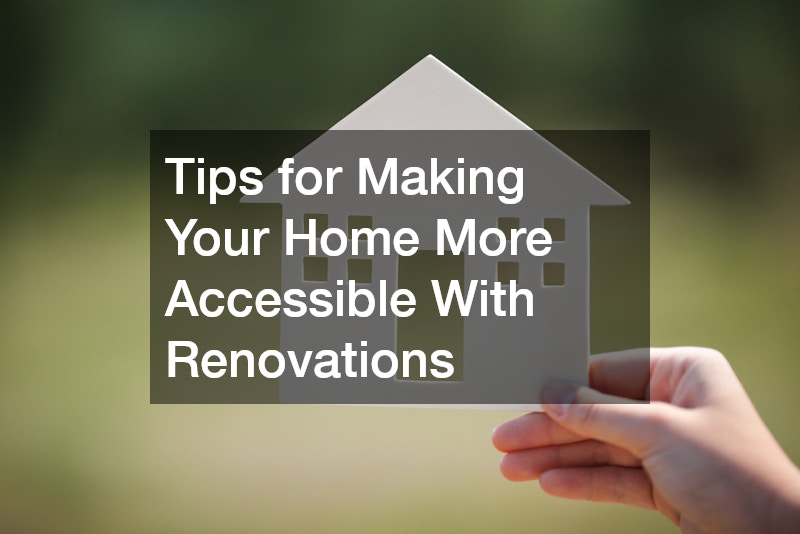As the population ages, and more people strive for independence, the need for accessible home features is becoming more evident. Whether you’re renovating your current home or building a new one, there are numerous ways to make your living space more accessible and convenient. Home renovations can drastically improve mobility, safety, and comfort for individuals with physical limitations or aging family members.
Making your home more accessible doesn’t necessarily mean compromising on style or comfort. You can achieve a functional, accessible home with thoughtful design choices that cater to your needs without sacrificing aesthetics. This guide will outline several renovations that can make your home more accessible, from simple updates to more complex projects, to help create a safe and comfortable environment for everyone.
1. Plan Ahead for Accessibility
One of the first steps in making your home more accessible is to plan ahead. Accessibility needs can vary based on personal health, age, or temporary circumstances like injury recovery. Whether you’re remodeling an existing home or working with a custom home builder for new home construction services, it’s essential to consider the layout, flow, and features of your home to ensure they meet current and future needs.
Things to consider in the planning stage:
-
Door widths: Consider widening doors to accommodate wheelchairs, walkers, or scooters.
-
Hallways and paths: Ensure there’s enough space for easy movement between rooms.
-
Flooring: Opt for slip-resistant, level surfaces, such as hardwood or low-pile carpeting.
Planning these changes early on can help prevent costly retrofits and make the process smoother. Working with professionals like home automation companies and bath remodelers can ensure that your design choices integrate seamlessly into your home.
2. Optimize Kitchen Functionality
The kitchen is often the heart of the home, and making it more accessible can drastically improve your daily life. When planning your kitchen remodeling service, focus on layout adjustments that accommodate mobility aids and increase ease of use for individuals with limited physical ability.
Key kitchen improvements to consider:
-
Lower countertops and cabinets: If standing for long periods is difficult, lowering countertops can make meal preparation more accessible. A skilled kitchen cabinet design specialist can help create custom cabinets that are at a comfortable height.
-
Pull-out shelves and drawers: Incorporating pull-out shelves in cabinets and drawers can help reduce the need to bend down or stretch, improving accessibility and efficiency.
-
Touchless faucets: Touchless faucets are especially helpful for individuals with limited hand mobility. Installing these faucets in the kitchen is a simple yet effective way to promote independence.
Making these adjustments can ensure that your kitchen is functional and easy to navigate, whether you’re cooking, cleaning, or simply enjoying time with family.
3. Renovate the Bathroom for Accessibility
The bathroom is another key area to focus on when making your home more accessible. Many people face challenges in the bathroom, especially when it comes to maneuvering around the space or managing personal care tasks. A bathroom remodeling project can introduce a wide range of features to enhance accessibility and safety.
Bathroom updates to improve accessibility include:
-
Walk-in showers with seating: Traditional bathtubs can be difficult to access for individuals with mobility issues. A walk-in shower with a built-in bench or foldable seat provides more comfort and safety during bathing.
-
Grab bars: Installing grab bars near the toilet and in the shower or tub is one of the simplest and most effective ways to improve safety in the bathroom.
-
Raised toilets: Higher toilets reduce the effort required to sit down and stand up, making it easier for people with limited mobility to use the restroom independently.
-
Non-slip flooring: Non-slip tiles or rubber flooring can help reduce the risk of falls, especially in wet areas like the bathroom.
By working with experienced bath remodelers, you can incorporate these features into your bathroom remodel, creating a safe and comfortable environment that suits your needs.
4. Upgrade Your Garage for Accessibility
The garage is often overlooked when it comes to accessibility, but it can be one of the most important areas to address in your home renovation. Making your garage more accessible ensures that individuals with mobility challenges can safely store and retrieve items from their vehicle, as well as move around the space without obstruction.
Ways to make your garage more accessible:
-
Garage door openers: Install an automatic garage door opener with easy-to-use controls that allow for easy access without needing to get out of the car. Modern garage door openers come with additional features like remote access via smartphones, making it even more convenient.
-
Wider garage door: If possible, widen the garage door opening to accommodate larger vehicles or to allow for smoother access in and out of the space.
-
Adequate lighting: Ensure your garage is well-lit to reduce the risk of accidents. Motion sensor lights can be a great addition to ensure the space is always illuminated when needed.
These upgrades make it easier to use your garage safely, whether you’re coming and going, storing personal items, or working on DIY projects.
5. Embrace Solar Energy
One of the most forward-thinking home upgrades you can make for accessibility is the installation of solar energy systems. Solar power not only supports environmental sustainability, but it can also make your home more energy-efficient, reducing utility costs. Additionally, solar power can help ensure a reliable energy source for critical home automation systems that enhance accessibility.
How solar energy can make your home more accessible:
-
Reduced reliance on traditional energy sources: Solar energy can power various home systems, including heating, cooling, and home automation features, ensuring your home remains functional even during power outages.
-
Support for home automation systems: With an eco-friendly energy source, you can install and maintain home automation systems that allow for greater independence, such as remote-controlled lighting, smart thermostats, and automated door locks.
The integration of solar energy into your home can contribute to long-term savings while making your home more adaptable and self-sufficient.
6. Consider Custom Home Construction
If you’re planning a new home, hiring a custom home builder gives you the opportunity to design every aspect of your living space with accessibility in mind. New home construction services allow you to create a space that caters specifically to your needs, with no limitations imposed by pre-existing structures or layouts.
Key considerations when working with a custom home builder:
-
Universal design: A custom builder can help incorporate universal design principles that make your home more adaptable to changing needs over time.
-
One-story layout: Consider building a single-story home to avoid the challenges posed by stairs.
-
Wider hallways and doorways: Customizing your home’s layout can ensure that all spaces are easy to navigate, even for individuals using mobility aids.
Working with a custom home builder allows you to create a space that’s not only accessible today but can be easily modified in the future.
7. Invest in Home Automation for Independence
Home automation companies offer solutions that make it easier to control various aspects of your home from a smartphone, tablet, or voice-controlled device. Automated systems can improve accessibility for individuals with physical disabilities by allowing them to manage their environment with ease.
Examples of home automation to consider:
-
Smart lighting: Automating your home’s lighting allows you to turn lights on or off from a distance, minimizing the need to move around the house.
-
Smart thermostats: A smart thermostat allows you to adjust the temperature from a mobile device, ensuring comfort without needing to physically interact with the thermostat.
-
Automated doors and locks: Installing smart locks and door openers can enable easy entry and exit from the home, ideal for individuals with limited mobility.
By integrating these technologies into your home, you can significantly enhance accessibility and comfort.
8. Adapt for Local Manufactured Homes
If you’re living in or planning to move into a manufactured home, there are plenty of modifications you can make to increase accessibility. Local manufactured homes are often smaller and may have layout limitations, but they can be renovated to offer improved mobility, convenience, and functionality.
Accessibility upgrades for manufactured homes:
-
Ramp installation: If the entryway has stairs, installing a ramp is an easy way to improve accessibility for wheelchair users or individuals with limited mobility.
-
Wider doorways and hallways: Manufactured homes often have narrower doorways and hallways, but these can be widened to accommodate mobility devices.
-
Adjustable countertops: Just like in traditional homes, adjustable-height countertops in the kitchen or bathroom can make tasks easier for everyone.
With a little planning, a manufactured home can be transformed into an accessible and comfortable living space for individuals with varying needs.
Making your home more accessible with renovations is a worthwhile investment that can improve safety, mobility, and overall comfort. Whether you’re remodeling your kitchen or bathroom, upgrading your garage, or investing in home automation, there are numerous ways to enhance accessibility in your living space. Working with professionals, such as bath remodelers, kitchen cabinet design specialists, or a custom home builder, can help ensure your home is not only functional but also meets your unique needs.
By taking the time to plan for accessibility now, you can enjoy a safer, more convenient living environment for years to come. If you’re ready to begin making these renovations or need help with any aspect of your project, reach out to local experts in your area to get started on transforming your home into a more accessible space.


